  |
|
 |
 |
|
Welcome to the Infant &
Child Development Lab
| Did you know...... |
|
| Newborns have very
poor visual acuity. |
 |
 |
Your optometrist
measures your visual acuity by asking you
to read an eye chart until the letters become
too small. To measure infants' visual acuity,
we take advantage of the fact that babies
look longer at patterned visual stimuli (e.g.,
stripes) than plain stimuli (e.g., a gray
square). To measure infants' visual acuity
we present them with a series of cards, each
of which has black-and-white stripes on only
one side. With each successive card, the stripes
get smaller. The smallest stripes that still
elicit looking indicate the baby's acuity.
Stripes must be about 30x wider for a newborn
than for an adult. |
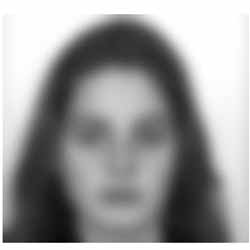 |
As a result, faces look something like
this to a
1-month-old.
|
| Newborns like faces! |
| Our studies have shown that even newborn
infants look preferentially towards face-like
stimuli. |
In addition, adults and children alike are
delighted to interact face-to-face with young
infants! |
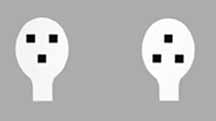 |
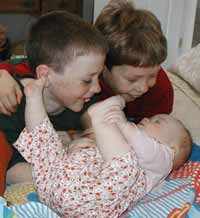 |
Even though the faces are blurry,
this early experience 'sets up' the brain
for later learning.
Our work has shown that infants who miss early
experience with faces because they are born
with cataracts in both eyes have permanent
deficits in some aspects of face processing.
For example, they perform poorly when asked
to recognize a face from a new point of view
(i.e., when asked to recognize a profile view
after seeing a face 'en face'). |
| Adults are experts at
processing faces but this expertise develops
very slowly. |
| Our research has
shown that adults are able to discriminate
faces based on the shape of individual features
(e.g., the eyes), the shape of the external
contour (e.g., the chin), and the spacing
among features (e.g., the distance between
the eyes). It is adults' sensitivity to the
spacing among features that allows them to
recognize a face from a novel point of view
or under poor lighting conditions. Our research
has shown that this sensitivity is very slow
to develop. Even 14-year-olds make more errors
than adults! Preschool children appear very
insensitive to the spacing of facial features.
They do notice when we move features too
far apart - so far as to make the face look
grotesque to adults. |
 |
|
However, when shown 2 realistic versions
of their own face -- one unaltered and one
with the eyes moved up -- 4 year-olds are
unable to 'choose' the correct face!
|
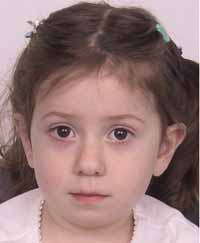 |
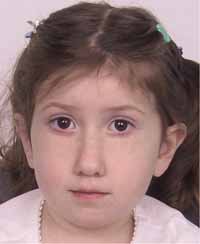 |
|
Our research is contributing to understanding
the normal development of face processing.
The tasks that we have developed are being
used by researchers around the world to
investigate face processing in a variety
of special populations (e.g., children with
autism, children with William's syndrome,
children with infantile brain lesions).
We depend on the
willingness of parents and their children
to participate in our research and would
welcome a visit from your family!
|
You are invited to read the following letters that we deliver each year to parents at our participating schools.
|
|
|
 |
 |
|
|
|
|
|

